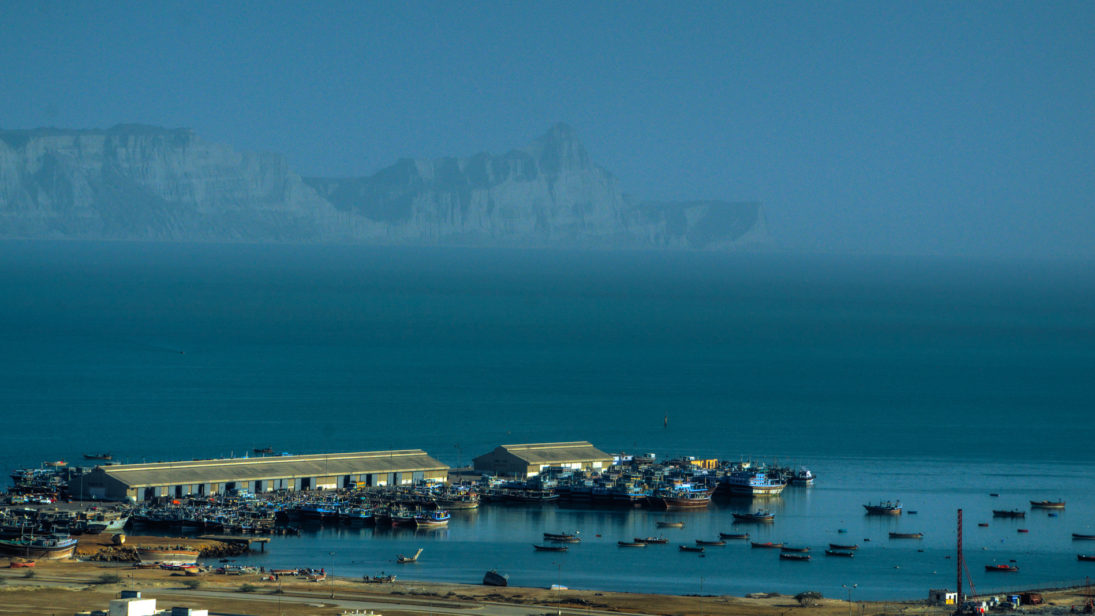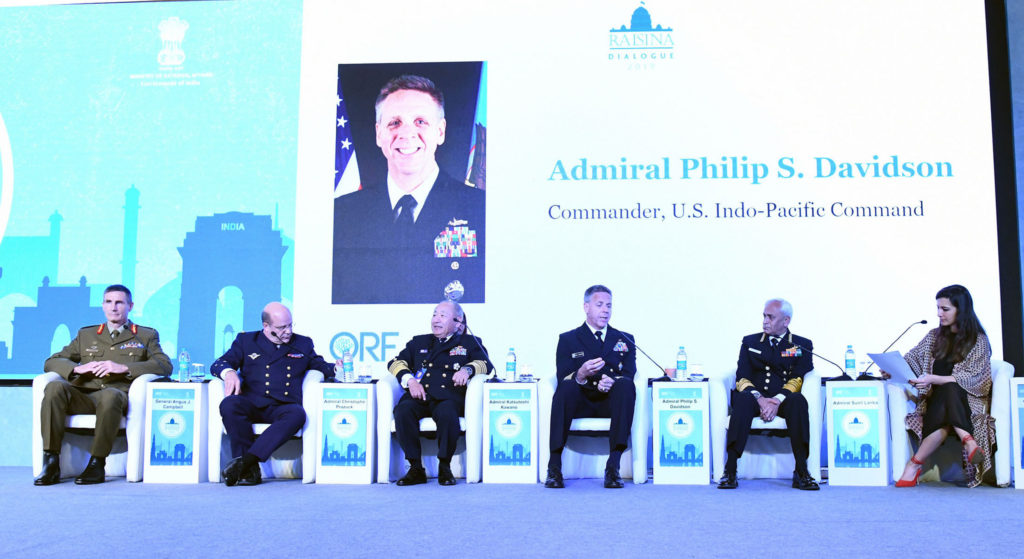
The naval commanders’ panel at the recently-held Raisina Dialogue hosted by the Indian Ministry of External Affairs and the Observer Research Foundation in New Delhi reflected the current strategic reality of a mounting anti-China coalition in the Indo-Pacific. In the panel, the five naval commanders present often alluded to China’s expansionist designs in the Indo-Pacific region as well as plans to enhance cooperation in the maritime domain to counter Beijing. Commander U.S. Indo-Pacific Command (INDOPACOM) Admiral Davidson, in response to a question on maintaining the balance of power in the region, hinted at the formation of anti-China alliances by stating: “the capability set that I think must be displayed and put in the battlespace is the set of alliances and partnerships that we are all capable of.” Admiral Davidson and Indian Naval Chief Sunil Lanba agreed that ties between India and the United States are burgeoning and strategic in nature and committed to enhancing interoperability and overall cooperation. More importantly, Admiral Davidson termed China’s Belt and Road Initiative (BRI) an exclusive and predatory project, associating it with coercion. These wide-ranging discussions reveal that Pakistan, with its deep sensitivities regarding New Delhi-Washington military cooperation and the BRI, is becoming caught in the geopolitical crossfire of this anti-Beijing discourse.
TheIndia Factor
Washington’s tilt toward New Delhi has long been irksome for Pakistan. With the scale of cooperation between the United States and India growing because of a renewed U.S. focus on great power competition in the Indo-Pacific, Pakistan is becoming increasingly anxious about the extent of Indo-U.S. military cooperation. Last year’s designation of India as a Major Defense Partner of the United States has allowed for new agreements and authorizations to facilitate interoperability between the two countries’ militaries through joint exercises, an increase in India’s license-free access to dual-use and high-end military products, and a boost in bilateral defense cooperation to a much higher level.
It is worth noting that the origins of modern Pakistan-U.S. relations were a result of Islamabad’s bid to strengthen its military to secure itself from an onslaught from India. Three prominent grievances have dominated U.S. discourse on Pakistan since the beginning of their capricious relationship: Islamabad’s using arms meant to fight communism against India in the 1965 war, its acquisition of a nuclear deterrent, and its allegedly subversive role in Afghanistan. Thus, India was a cause of Pakistan’s early embrace of Washington, but soon became a decisive factor in making or breaking this transactional relationship. So long as Pakistan and India do not take significant steps bilaterally to build bridges, Pakistan will not find the U.S.-Indian defense camaraderie innocuous.
So long as Pakistan and India do not take significant steps bilaterally to build bridges, Pakistan will not find the U.S.-Indian defense camaraderie innocuous.
One of Islamabad’s principal concerns pertains to India’s role and footprint in Kabul, something that Washington wanted to increase under the aegis of Trump’s South Asia Policy. While a prospective peace deal in Afghanistan may somewhat mitigate the gulf between the United States and Pakistan, the latter’s concerns about Washington’s bonhomie with India in the Indo-Pacific will not only aggravate Pakistan’s security concerns, but also its apprehensions about the United States, something that will mar ties between the two countries even if the war in Afghanistan ends.
Pakistan may also feel threatened by a more militarized India that has time and again threatened to militarily punish Pakistan due to its alleged involvement in crossborder terrorism. In a crisis, Pakistan may doubt the United States’ ability or willingness to mediate between the conflicting parties and may even blame Washington for not reining in India. While robust crisis diplomacy by the United States has in the past prevented escalation to higher rungs of the escalation ladder, neither of the conflicting parties was assured by Washington’s go-between role across the three post-1998, despite its efforts to prioritize de-escalation over its geopolitical goals until crisis termination. Now that ties with India have deepened on a strategic level, the United States’ ability the play the role of a neutral arbiter may be more in question than ever. Pakistan is likely to doubt Washington’s good offices in a future crisis because since the last major Indo-Pak crisis in 2008, Washington-New Delhi relations—much to Pakistan’s chagrin—have bolstered.

An Updated U.S. Footprint to Counter BRI
Pakistan views the Indo-U.S. alignment of interests as way of both countries managing the threat from China. The U.S. posture in the Indo-Pacific has been calibrated to align the threat assessments enshrined in the latest U.S. National Defense Strategy 2018. Last year, Admiral Davidson in his testimony before the United States Senate Committee on Armed Services commented on “ensuring the continued combat readiness of assigned forces in the western Pacific; developing an updated footprint that accounts for China’s rapid modernization.” According to him, the Chinese, through BRI and their actions in the South China Sea, “are clearly executing deliberate and thoughtful force posture initiatives.” Additionally, Admiral Davidson claims that although “China claims that these reclaimed features and the Belt and Road Initiative will not be used for military means…their words do not match their actions.”
This U.S. threat assessment’s vis-a-vis China’s BRI and indirectly CPEC should make Pakistan cautious about America’s deepening ties with India in the Indo-Pacific. Indeed, BRI is the hallmark of China’s rapid modernization in the region. While an “updated footprint” might not necessarily have a military component, it certainly will have an economic one. This will have implications for Pakistan: Islamabad and Beijing’s ties are historic, strong, and strategic in nature. The China-Pakistan Economic Corridor (CPEC), considered a flagship project of the BRI, connects China’s city of Kashgar with Pakistan’s Gwadar port city. Any targeting of Beijing through military or economic means has the potential to damage Pakistan’s economy as well.
This U.S. threat assessment’s vis-a-vis China’s BRI and indirectly CPEC should make Pakistan cautious about America’s deepening ties with India in the Indo-Pacific.
The situation could be aggravated if and when the United States withdraws troops from Afghanistan. China has not only increased its activities in Afghanistan since 2014, but also expressed interest in expanding CPEC to that country. A likely departure of the United States from Afghanistan will give China an open field to wield influence in Kabul through economic diplomacy. The United States will be constrained to counter China in Afghanistan after its departure primarily because its regional partner, India, has shown aversion to deploying its troops in that country. However, the United States may offset China’s gains in Afghanistan by using its ties with India to good effect in the Indian Ocean region. In a bid to create a bulwark against China’s expansion towards West Asia, military cooperation will likely continue to enhance between New Delhi and Washington, posing threats to both China and Pakistan.
Conclusion
In sum, the United States’ new Indo-Pacific Strategy that aims to counter Beijing’s growing influence by bolstering India in the region will strain ties between Pakistan and the United States in two ways. First, Pakistan could deem Indo-U.S. joint opposition and concern about the BRI to be punishing Pakistan’s closest strategic partner, China. But most importantly, the trust deficit between the two countries will increase due to United States’ growing defense relations with India, something that would have implications for Washington’s credibility as a crisis manager in the region.
***
Image 1: umairadeeb via Flickr
Image 2: MEAphotogallery via Flickr


